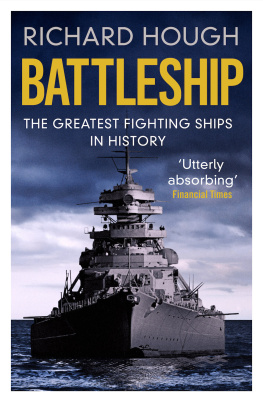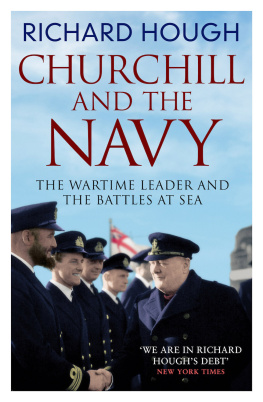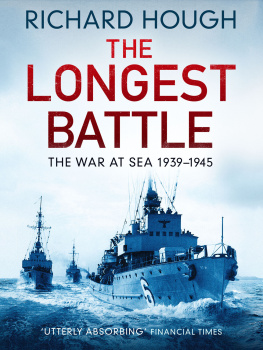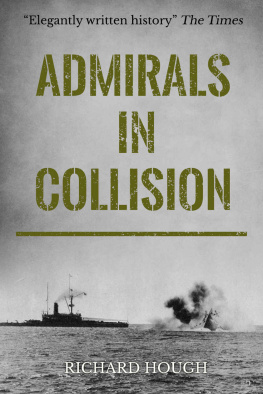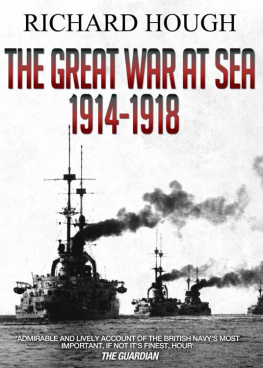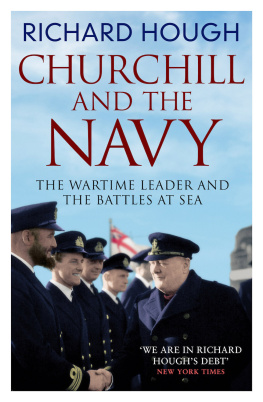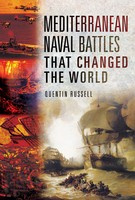NAVAL BATTLES OF THE TWENTIETH CENTURY
Richard Hough
Richard Hough 2014
Richard Hough has asserted his rights under the Copyright, Design and Patents Act, 1988, to be identified as the author of this work.
First published in Great Britain 1999 by Constable and Company Limited.
This edition published in 2014 by Endeavour Press Ltd.
FOR MY WIFE
Table of Contents
Introduction
I HAVE SELECTED fourteen naval battles of the twentieth century to include in this book. They range from the Battle of Tsu-Shima in 1905 to the Battle of the Philippines in 1944. These two battles are separated by almost fifty years and mark the rise of the Japanese Navy to become a great naval power; and then later its destruction. Both these battles took place in the eastern hemisphere, and the British Navy, having been the dominant naval power in the nineteenth century, took part in neither.
However, all but four of the other battles recounted in this book involved the Royal Navy, including the second biggest, the Battle of Jutland in 1916.
Between the World Wars it became increasingly evident that the nature of war at sea was changing radically, and that air power might become the dominating factor. Gone were the days when a naval battle featured a line of battleships firing their guns at one another from, say, a range of 200 or 300 yards, stretching to 12,000 or 15,000 a hundred years later.
Now, as became evident from 1940 onwards, battle fleets might destroy one another from ranges limited only by the amount of fuel in the tank of an aircraft. These battle fleets did not use range-finders because they could not even see one another.
At the Battle of Jutland in 1916 battleships of 25,000 tons, costing about 2,000,000, pitted themselves against one another, firing shells weighing anything up to 2,000 pounds. When these large-calibre shells made a hit in the right place, just one might suffice to destroy an enemy ship of equal size, as happened several times at Jutland.
Twenty-five years later a handful of aircraft, each costing about 10,000 to build, crippled an entire fleet with the loss of only two of them. At the Battle of Midway in the Pacific, four Japanese aircraft carriers were destroyed in one day for the cost of a handful of bombers, meanwhile altering the balance of power in that war. Yet no heavy guns had been fired and the enemy had been located by scouting planes or radar.
By 1940 the battleship was obsolescent, as predicted by General 'Billy' Mitchell years earlier, as well as by other far-sighted authorities. The battleship and its cousin, the battle-cruiser, had become useful only for bombarding land targets and providing protection for the new dominant warship - the aircraft carrier.
Attempts by Germany in the Second World War to use battleships and battle-cruisers for commerce raiding turned out disastrously, the biggest of them, the Bismarck , being crippled by a single plane before being sunk by guns and torpedoes.
The torpedo as a weapon of sea warfare had been invented many years earlier. Destroyer-borne torpedoes had crippled the Russian Fleet at the outset of the Russo-Japanese war of 1904-5. The torpedo was rapidly developed; ten years after that event one torpedo sank the only German battleship to be destroyed at Jutland. Only one torpedo was needed for the Pommern to blow up and immediately sink.
A torpedo carried by a plane, secured under its belly, made a lethal combination. This was developed in the 1920s and 1930s, and all major naval powers used it in the Second World War.
The dive-bomber was also a new weapon widely used in that war. At the surprise attack on Pearl Harbor by the Japanese Navy in 1941, dive-bombers and torpedo bombers all but wiped out the American battleship fleet. But it was not the stunning victory the Japanese claimed it to be because there were no carriers there; moreover this 'sneak' attack so stirred the pride and anger of the American people that the industry of that nation, the greatest in the world, before long was launching a new carrier every week.
All of the battles fought in the Pacific and described in this book feature the carrier, and it was the skill and courage of American air crews, flying from carriers, which turned the tide in the battle to control this enormous, 70,000-square-mile ocean.
I have not chosen to discuss in detail the submarine-launched torpedo, except incidentally. It did indeed have successes against carriers and all types of warship, from battleships to destroyers, and it can be argued that the greatest battles of the twentieth century were fought by submarines operating in the Atlantic and Pacific Oceans.
Certainly the German U-boat operations in both World Wars in the Atlantic came nearer to bringing Britain and her allies to their knees in this new form of commerce warfare - the guerre de course . But that, perhaps, might be the subject of another study.
This book tends to concentrate its attention on battles on the sea rather than beneath the waves, and to illustrate the development of sea warfare, from the ironclads through the all-big-gun dreadnought to the aircraft carrier - the 'Queen of the Seas' even before the end of the twentieth century.
1 - The Battle of Tsu-Shima
26 May 1905
ONE HUNDRED YEARS after victory at the Battle of Trafalgar had given Great Britain control of the seas, there took place on the other side of the world one of the most decisive sea battles of all times. The victors, this time, were the Japanese.
Japan, historically a shut-off and secretive nation, had come out into the real world less than fifty years earlier. In 1867 the Shogunate was abandoned and the Emperor was returned to his divine status. At the same time Japan followed the Western policy of nationalistic imperial aggression. Formosa was annexed in 1894, and the economy of Korea was dominated by Japan. Industries, also based on Western practice, sprang up. Men-of-war were ordered from British yards, and when they arrived in Japan were closely studied and imitated. Guns of all calibres were made at the new ordnance shops.
Training of officers and men, and their ranks and uniforms, were based on the British way, too. Emulating Western practice, there developed in Japan a lust for expansion, for imperialism. In Japan's case there was some justification because, like Britain, the Japanese islands were overcrowded and a foothold on the Asian land mass would relieve some of the pressure. The war with China in the 1890s was an overture to the more formidable and risky enterprise against Russia.
The Imperial Japanese Navy's Commander-in-Chief was Admiral Heihachiro Togo. He was a fierce and feared officer, dedicated to his service and the Mikado, a patriot respected by all those serving under him, but much loved by them, too.
Like many Japanese naval officers, Togo was sent to England, which possessed the largest and most admired navy in the world, for his training. Here Togo learned not only the language but about Britain's naval heroes of the past, and especially Horatio Nelson, whose flagship, Victory , he visited in Portsmouth harbour. Thereafter, Togo based his strategic and tactical principles on those of the great master. He spent two years as a cadet on board the three-masted sailing ship Worcester . This was followed by a round-the-world cruise on board the training ship Hampshire , with a long spell ashore at Melbourne, Australia. He then returned to London by Cape Horn, completing a voyage of 30,000 miles.
Togo concluded his studies at Cambridge University and was about to return home when a signal from Japan ordered him to monitor the construction of one of the first warships to be ordered from Britain, the Fuso , building at Poplar on the River Thames.


